Brainlord Mesomorph
Well-Known Member
- Joined
- Apr 2, 2018
- Messages
- 266
- Reaction score
- 26
Sorry, I wan't clear.
Look at this pic:

On the left we have the roll of 16 gauge wire that I already bought for this job.
Clockwise, the main power toggle w/ big screw terminals, the Ignition button, the Keyswitch, another button, the piezo, an LED and the Continuity Test button in the middle (with the little tiny terminals). All of these are 12V 10A parts (at least).
Now I certainly plan to use the 16 gauge wire for the battery terminals and main power and ignition and the XLR connectors to the pad.
But that lighter duty wire they used for the leads on the LED and piezo is obviously adequate for those purposes and isn't that right wire for the continuity test and the little electronic connections in the box?
Don't I need a roll of that too?
Look at this pic:

On the left we have the roll of 16 gauge wire that I already bought for this job.
Clockwise, the main power toggle w/ big screw terminals, the Ignition button, the Keyswitch, another button, the piezo, an LED and the Continuity Test button in the middle (with the little tiny terminals). All of these are 12V 10A parts (at least).
Now I certainly plan to use the 16 gauge wire for the battery terminals and main power and ignition and the XLR connectors to the pad.
But that lighter duty wire they used for the leads on the LED and piezo is obviously adequate for those purposes and isn't that right wire for the continuity test and the little electronic connections in the box?
Don't I need a roll of that too?







